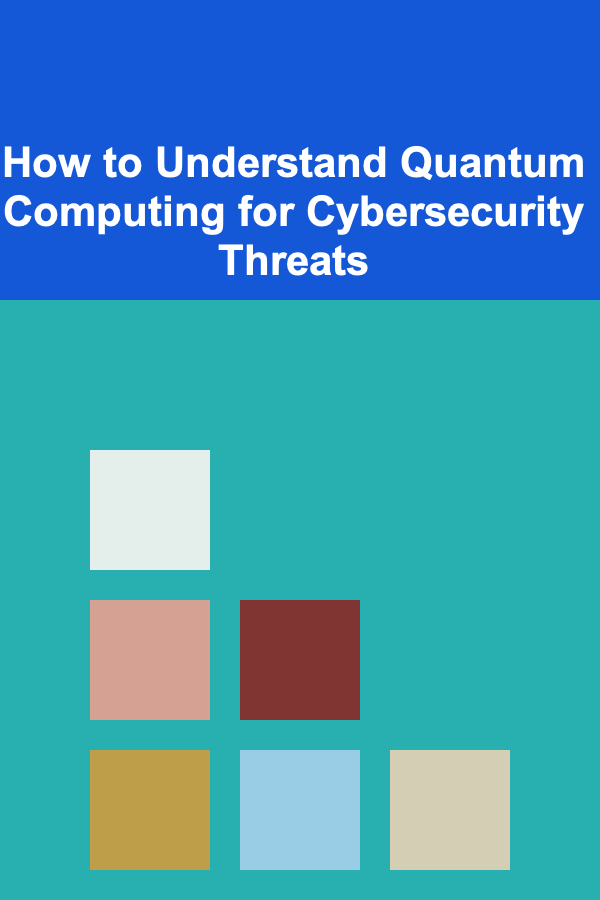
How to Understand Quantum Computing for Cybersecurity Threats
ebook include PDF & Audio bundle (Micro Guide)
$12.99$8.99
Limited Time Offer! Order within the next:

Quantum computing, a cutting-edge area of research, promises to revolutionize the way we approach computation. While it holds great potential for many industries, it also brings significant challenges, particularly in the field of cybersecurity. As quantum computers become more advanced, they could disrupt many of the encryption systems that currently protect our data. This article will explore how quantum computing interacts with cybersecurity, the potential threats it poses, and what steps we can take to address these challenges.
Introduction to Quantum Computing
At its core, quantum computing harnesses the principles of quantum mechanics to process information in fundamentally new ways. Classical computers use bits as the smallest unit of information, which can be either 0 or 1. In contrast, quantum computers use quantum bits or qubits . These qubits can exist in multiple states simultaneously due to a phenomenon known as superposition. Additionally, quantum computers exploit entanglement, where qubits become correlated in ways that classical bits cannot. This allows quantum computers to solve certain types of problems much faster than classical computers.
Quantum computing is still in its early stages, but it is progressing rapidly. Companies such as IBM, Google, and Microsoft are leading the charge in developing quantum computing hardware and software. However, as promising as these technologies are, they also present significant risks, especially when it comes to cybersecurity.
The Threats of Quantum Computing to Cybersecurity
Breaking Classical Cryptography
Classical cryptographic methods, such as RSA, ECC (Elliptic Curve Cryptography), and AES (Advanced Encryption Standard), rely on mathematical problems that are extremely difficult for classical computers to solve. These encryption algorithms are the backbone of many cybersecurity systems, securing everything from online banking transactions to private communications.
However, quantum computers have the potential to break these encryption methods with relative ease. The primary reason lies in the power of quantum algorithms. Two of the most concerning quantum algorithms for cryptography are Shor's Algorithm and Grover's Algorithm.
Shor's Algorithm
Shor's Algorithm, developed by mathematician Peter Shor in 1994, can factor large numbers exponentially faster than the best-known classical algorithms. This is critical because many public-key cryptosystems, like RSA, rely on the difficulty of factoring large numbers as a security feature. If a quantum computer can run Shor's Algorithm efficiently, it would be able to break RSA encryption, rendering many of today's security protocols obsolete.
For example, RSA encryption relies on two large prime numbers. Multiplying them together is easy, but factoring the result into its prime components is computationally expensive and time-consuming for classical computers. However, a quantum computer using Shor's Algorithm could factorize these large numbers in a fraction of the time, breaking RSA encryption within seconds or minutes instead of years.
Grover's Algorithm
While not as immediately threatening as Shor's Algorithm, Grover's Algorithm still poses a significant risk to symmetric key cryptography (such as AES). Grover's Algorithm can search through an unsorted database of possible solutions in O(√n) time, a significant improvement over classical algorithms that require O(n) time. For symmetric encryption algorithms, Grover's Algorithm could reduce the security of a key by half.
For instance, AES-256, which is currently considered secure against classical attacks, would only offer the equivalent security of AES-128 against a quantum adversary. While this is still relatively strong, it would be a concern for highly sensitive data that requires long-term protection.
Quantum-Resistant Cryptography
The advent of quantum computing necessitates the development of new cryptographic methods that can withstand the power of quantum algorithms. Quantum-resistant cryptography, also known as post-quantum cryptography, refers to cryptographic techniques designed to be secure against the capabilities of quantum computers.
Researchers are currently investigating a variety of quantum-resistant algorithms, including lattice-based cryptography, hash-based cryptography, multivariate polynomial cryptography, and code-based cryptography. These methods are designed to be difficult to break even by quantum computers running algorithms like Shor's and Grover's.
The National Institute of Standards and Technology (NIST) has been at the forefront of this effort. In 2016, it began a multi-phase process to standardize post-quantum cryptographic algorithms. This effort is crucial because it will ensure that as quantum computing becomes more powerful, the infrastructure for securing digital information can evolve in parallel.
The Impact of Quantum Computing on Cybersecurity Systems
Data Breaches and the Threat to Sensitive Information
One of the most significant concerns about quantum computing is its potential to compromise sensitive data. With the ability to break current encryption methods, quantum computers could lead to massive data breaches, exposing confidential information stored in data centers, cloud services, and personal devices.
For example, attackers using quantum computers could decrypt stored encrypted communications and documents, even those that were considered secure when initially encrypted. This "harvest now, decrypt later" scenario is a significant risk for governments, corporations, and individuals who rely on encryption to protect their sensitive data.
The Future of Secure Communication
Quantum computing also has implications for secure communication systems. Protocols like TLS (Transport Layer Security), which secure websites and online transactions, rely on classical cryptographic algorithms. If quantum computers can break these encryption methods, secure communication over the internet could be compromised.
However, quantum computing also offers a potential solution to this problem: Quantum Key Distribution (QKD). QKD uses the principles of quantum mechanics to securely exchange encryption keys. With QKD, any attempt to eavesdrop on the key exchange process would alter the quantum state of the transmitted information, alerting the parties to a potential interception.
While QKD shows promise, its implementation faces several challenges. For one, it requires specialized hardware and is limited by distance, as quantum information is prone to degradation over long distances. Nevertheless, QKD could become an essential component of secure communication networks in the future.
Cryptographic Backdoors and Quantum Hacking
Another potential threat from quantum computing lies in the creation of quantum-based backdoors. Traditional backdoors in cryptographic systems are often introduced by malicious actors who exploit vulnerabilities in the software or hardware. With quantum computing, it could become easier to create sophisticated backdoors that are nearly impossible to detect using classical methods.
For example, attackers could use quantum algorithms to break into systems and insert a backdoor without leaving any traces detectable by conventional cybersecurity tools. This could lead to an entirely new wave of cyberattacks, where the attackers' presence goes unnoticed for extended periods.
Quantum Hacking and Quantum-Enabled Malware
As quantum computing advances, the possibility of quantum hacking and quantum-enabled malware increases. Quantum hacking refers to the use of quantum computers to break into systems, bypassing traditional security measures. Quantum-enabled malware could leverage quantum algorithms to evade detection or destroy encryption keys, making data unreadable or stealing critical information.
The speed and power of quantum computers could give attackers a significant advantage in executing cyberattacks. While quantum-enabled malware is still theoretical, it is important to begin preparing for the possibility by developing countermeasures.
Preparing for the Quantum Threat: Steps for Cybersecurity Professionals
Transitioning to Post-Quantum Cryptography
One of the most critical steps in preparing for the quantum threat is transitioning to post-quantum cryptographic systems. This involves migrating from traditional encryption algorithms, such as RSA and ECC, to quantum-resistant algorithms. The transition will require significant effort from organizations, as it involves updating infrastructure, software, and hardware systems.
The NIST's standardization process will provide valuable guidance, and cybersecurity professionals should start planning for the implementation of quantum-resistant algorithms. These algorithms should be integrated into systems well before quantum computers become capable of breaking classical encryption methods.
Hybrid Cryptography
In the meantime, hybrid cryptography may be a practical solution. Hybrid systems combine classical and post-quantum cryptographic algorithms, ensuring that even if one of the algorithms is broken by a quantum computer, the other can still provide security. Hybrid systems can offer a temporary safeguard while quantum-resistant algorithms are further developed and tested.
Quantum Key Distribution (QKD) Networks
Organizations should also explore the integration of Quantum Key Distribution (QKD) into their cybersecurity infrastructure. While QKD is still in its early stages, it holds promise for securing communications against quantum threats. Governments and companies that require the highest levels of security should begin researching the feasibility of QKD networks.
Collaborating on Quantum Research
Collaboration with academic and industry researchers in the quantum computing field is crucial for staying ahead of emerging threats. Cybersecurity professionals must engage with the scientific community to monitor developments in quantum computing and work together to develop countermeasures.
Conclusion
Quantum computing represents both a major opportunity and a significant threat to cybersecurity. As quantum computers become more powerful, they could render current encryption methods obsolete, exposing sensitive data and communications to unprecedented risks. However, by embracing post-quantum cryptography, quantum key distribution, and other quantum-resistant technologies, we can build a future-proof cybersecurity infrastructure.
The transition to a post-quantum world will require time, resources, and collaboration. Cybersecurity professionals, researchers, and industry leaders must work together to address the challenges posed by quantum computing and ensure that digital systems remain secure in the face of this emerging technology.
By preparing now, we can mitigate the risks of quantum computing and ensure a secure digital future.

How to Build a Retirement Planning Checklist for Maximizing Savings
Read More
How to Create Attractive Labels for Your Antique Collection
Read More
How To Stay Secure on Public Wi-Fi Networks
Read More
How to Master Public Speaking with Confidence
Read More
How to Find New Artists in the Folk-Pop Scene
Read More
Renovating with Feng Shui in Mind: Planning for Positive Change
Read MoreOther Products

How to Build a Retirement Planning Checklist for Maximizing Savings
Read More
How to Create Attractive Labels for Your Antique Collection
Read More
How To Stay Secure on Public Wi-Fi Networks
Read More
How to Master Public Speaking with Confidence
Read More
How to Find New Artists in the Folk-Pop Scene
Read More